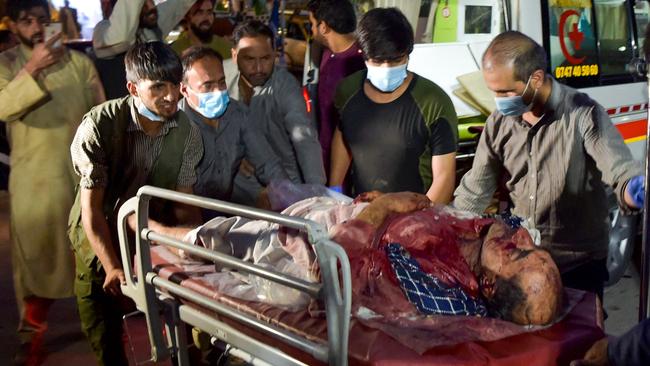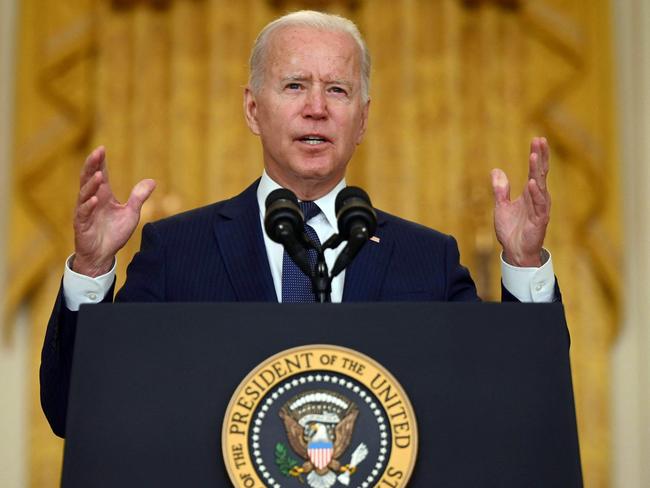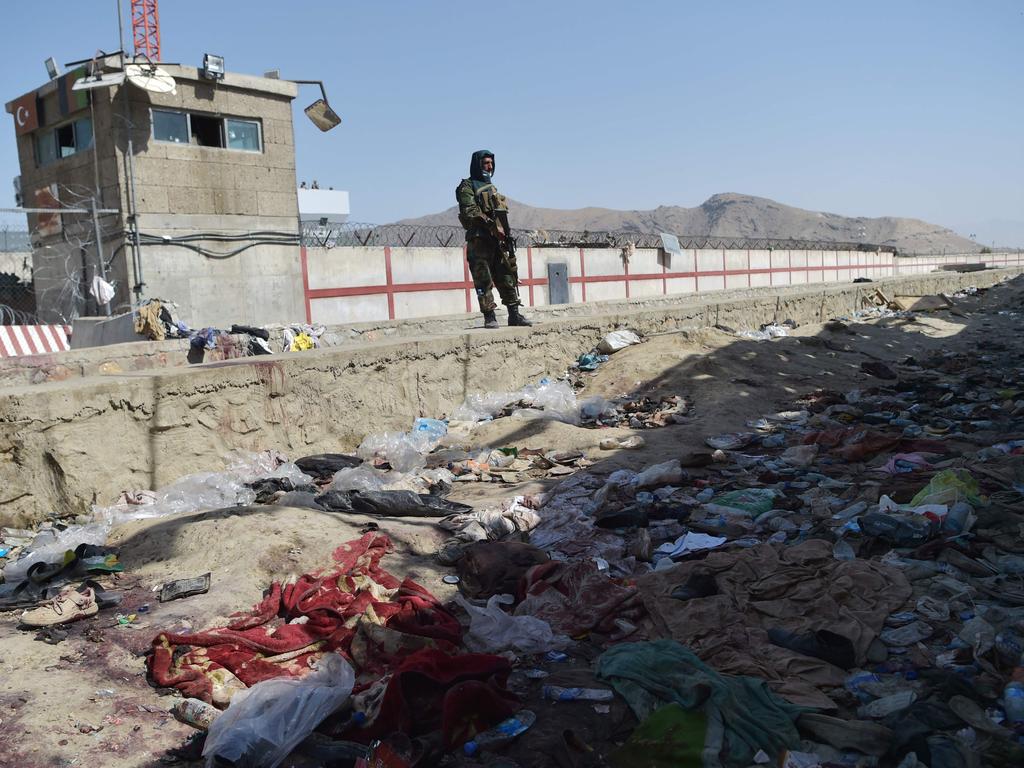Kabul terror attack: Afghans abandoned to a reign of terror
The West was warned many times that the Kabul atrocity was inevitable.

Sandwiched between their new Taliban overlords and the foreign forces trying to keep them out of Kabul airport as the biggest civilian airlift in history began to wind down on Thursday night, hundreds of Afghans camped outside the Abbey Gate had no chance.
As the smoke cleared from a suicide blast that Western intelligence agencies had for days warned was imminent, those who were still able pulled the injured from the sewage moat along the airport perimeter wall in which so many had stood for days waving visas and passports to the implacable soldiers above them.
Among the 90 or more civilians dead were children whose parents had brought them to the airport in the vain hope of delivering them a better life.
On the other side of the wall, US forces counted their own dead – 13 so far in the worst loss of American soldiers in Afghanistan since 2011. No Australian soldiers were injured in the attack.
The Taliban, too, sustained at least 28 deaths.
The first blast was detonated outside the airport’s Abbey Gate, where Australian officials have for days been directing Australians and those Afghans cleared for evacuation, and where ADF troops have been roaming the walls to spot them.
The second was outside the nearby Baron Hotel, where British forces have been processing their refugees. Gunmen also opened fire on the crowds and US forces after the bomb detonated.
“This is what happens when you surrender to a terrorist network,” former US national security adviser HR McMaster fumed in the immediate hours after the complex strike on Afghanistan’s capital, which is being blamed on the region’s upstart ISIS affiliate, Islamic State in Khorasan Province (known as ISKP or ISIS-K).
“What we are seeing is a jihadist terrorist state in Afghanistan.”
After 20 years of Western investment, is this what we leave behind – 35 million people caught between the opposing terrors of the Taliban’s brutal oppression and Islamic State’s nihilistic violence?
American “hearts ache for all the Afghan families that lost people, including children, in this vicious attack”, US President Joe Biden said on Friday.
“To those that carried out this attack, as well as anyone else who wishes America harm, know this: We will not forgive. We will not forget. We will hunt you down and make you pay.
“We will not be deterred by terrorists. We will not stop the mission. We will continue the evacuation.
“We will complete our mission and we will continue, after the troops are withdrawn, to define means by which we can find any American that wants to get out of Afghanistan. We will find them and we will get them out.”

All of those tasks will be immeasurably more difficult thanks to the Biden administration’s own dismantling of American forward military and intelligence bases in the course of its mishandled withdrawal.
By Friday morning, in a damning demonstration of where that weakness has left Western intelligence, US officials indicated they would work in tandem with the Taliban – their 20-year foe, the killers of thousands of allied troops, 137,000 Afghan soldiers and civilians.
General Kenneth McKenzie, who commands US forces in Afghanistan, said ISIS-K suicide bombers had evaded earlier Taliban checkpoints to reach US Marines and that more attacks should be expected.
But he had “seen nothing” to suggest the Taliban, which was helping US forces secure the airport, had facilitated the attacks.
“We share a common purpose (to get out by August 31). They have cut some of our security concerns down, they have been useful to work with,” he said.
In fact, the US military and the Taliban have been working together against ISIS-K since 2017 when they mounted a co-ordinated operation with Afghan government forces to dislodge the group from its Nangahar and Kunar strongholds.
The Taliban has used that fact as a selling point in its relentless campaign with regional powerbrokers and the US itself to win back control of Afghanistan, arguing that it would be a more effective counter-terrorism force than the Afghan government.
More than 104,000 foreign nationals and allied Afghan workers have been whisked out of Afghanistan’s mud-coloured capital in the past fortnight, along with doctors, engineers, journalists, artists, lawyers, politicians, students and activists in a monumental brain drain that will echo through the halls of government and industry for decades to come.
Australia has evacuated 4100 people, Britain more than 11,000 and the US 66,000.
The US and UK have vowed to continue evacuations though, in reality, the deadly attack has locked down the capital and few more civilians are likely to make it through the security perimeter.
All nations involved in the evacuation have conceded thousands will be left behind who deserve to be rescued; interpreters, embassy guards, UN staff, and so many academics, women activists and students promoted through the same Western embassy websites and social media pages the Taliban is now trawling for collaborators.
Just hours before the blast, Foreign Minister Marise Payne told the Human Rights Council in a video address that Australia was concerned about the potential for “further loss of life and suffering” in Afghanistan, as well as human rights abuses and an unfolding humanitarian crisis.
“We remain committed to helping Afghanistan build a stable and secure future,” she said.
By Friday morning, however, the government had confirmed that Australia’s evacuation mission from Kabul was over and that all troops and officials had been flown out of Afghanistan.
It was unclear whether arrangements had been made with British and American allies to fly any remaining visa holders out in their wake.
The US-led evacuation from Kabul, which by the August 31 deadline will have eclipsed the months-long civilian airlift out of Vietnam in 1975, had already gifted America’s strategic rivals a whole new gallery of pictures with which to demonstrate its apparent perfidy before Thursday night’s carnage.
Since the Taliban took Kabul on August 16, the world has seen Afghans fall from the undercarriage of a departing US military plane, and run the violent gauntlet of Taliban checkpoints.
Children have been passed over the airport wall to Western soldiers, and crowds of people have begged for help while standing waist-deep in sewage drains.
The fate of thousands of Afghans, whose work with Western governments has left them vulnerable to violent reprisals, has boiled down to their ability to bridge a deadly strip of ground between the mayhem of Taliban-held Afghanistan and the airport’s international ground.
Now there are more nightmare images; bloodied civilians ferrying the injured in wheelbarrows, dead children in pieces lying face down in that sewage drain just inches from potential saviours.
For Afghans, this is darkly familiar territory.
The newest jihadis on the block – a group that grew out of disaffected Taliban members with even harder-line views in 2015 – have struck the capital dozens of times in the past year, including deadly strikes on a Hazara girls high school and a maternity hospital.
Crisis Group consultant Ibraheem Bahiss says ISIS-K sleeper cells inside Kabul have been preparing for this moment since February 2020, when the Taliban agreed to end attacks on US forces and prevent Afghanistan from becoming a terrorism centre in exchange for a complete US troop withdrawal.
“Since the Doha Agreement, ISIS-K has been trying to reaffirm itself as the ‘pure’ jihadist group and the Taliban as having sold out to the Americans,” he told Inquirer.
“It is a different kind of actor that has attracted a lot of people from the Salafist ideology based in urban centres, as opposed to the Taliban which is a rural-based organisation.”
While there was plenty of warning that an attack was imminent, Bahiss says the Taliban – which secured the area outside the airport – had no expertise in crowd control or counter-terrorism.
It knows how to launch terror attacks, not prevent them. “They’ve been talking about the security situation improving in the country because they are now in control and not launching attacks, but now they’re in government and have to defend against insurgencies, it’s going to be a much more difficult battle,” said Bahiss.
“It’s always harder for government forces to defend against insurgents with a base of hardwired hardliners.”
The sense of betrayal felt by Afghans at their abandonment after years of Western promises is reverberating across the world.
Southeast Asian countries are watching with a sense of deja vu.
Singapore’s Lee Hsien Loong told visiting US Vice-President Kamala Harris this week: “What will influence perceptions of US resolve and commitment to the region will be what the US does going forward, how it repositions itself in the region, how it engages its broad range of friends and partners and allies. We hope Afghanistan does not become an epicentre for terrorism again.”
No matter how you slice it, the Taliban’s victory in Afghanistan is a boon for some of the baddest jihadists in the region – al-Qa’ida, the Haqqani network and Lashkar-e-Toiba – all of whom played a role in its conquest and will expect a reward.
“That’s a concern for us too because, at minimum, Afghanistan will be a huge sanctuary for jihadist groups. They will be able to live there, train, recruit and communicate,” says Douglas London, the CIA’s South and Southwest Asia counter-terrorism chief until his retirement in 2019 and a 34-year agency veteran.
Al-Qai’da has already benefited from the release of dozens of high-value jihadists from Bagram prison, and al-Qa’ida seniors are returning to Afghanistan from Iran, he says. “A real concern is how quickly they can reconstitute and how easy it will be for the Taliban to say; ‘We didn’t help them, we didn’t see anything’.
“At the end of the day, will the US, NATO or Australia reinvade Afghanistan if there’s a terrorist attack? I think they know that won’t happen.”
It was that same prisoner release that is believed to have strengthened ISIS-K’s capacity to launch its attack.
US, Australian and British officials on Thursday all cited intelligence – what’s left of it on the ground – of a “very high threat of terrorist attack” as they moved to wrap up civilian airlifts and begin a high-risk military retreat from an enemy armed with billions of dollars of captured US weaponry.
On Friday, General McKenzie revealed ISIS-K gunmen were also shooting at departing aircraft.
Canberra warned people not to come to the airport, while the UK government suggested: “If you can leave Afghanistan safely by other means, you should do so immediately.”
The US urged the thousands of people still outside the airport to go home. Most refused, perhaps calculating they had nothing left to lose.
THERE is plenty of blame to go around for the collapse of the Afghan government and military, and for the omnishambles of the Western withdrawal, which leaves behind a country likely to be plagued by violent insecurity, perhaps even civil war, for years to come.
Pakistan, which for years sheltered and aided the Afghan Taliban, now faces a heightened threat from its own jihadists plotting the downfall of the nuclear-armed state from across the border.
Donald Trump must shoulder responsibility for a deal with the Taliban some have likened to British prime minister Neville Chamberlain’s infamous 1938 Munich Agreement, which ceded Czechoslovakia to Nazi Germany.
The Afghan government, under President Ashraf Ghani and before him Hamid Karzai, did little to stamp out the endemic corruption that left Afghan soldiers unpaid for months, and with no will left to fight. President Biden is the architect of his own administration’s political disaster, having been repeatedly warned against setting a date for withdrawal, rather than a well thought-out strategy, without demanding a permanent ceasefire.
William Maley, an ANU emeritus professor and veteran Afghanistan analyst, also blames an entire “peace industry” that “swallowed this nonsense about a Doha peace process with the Taliban and, by their endeavours, blocked a proper focus on what the real dangers were”.
“The people who were the cheer squad for that process have all gone terribly silent in the last week or so,” he noted.
Now, the Taliban too – in its very moment of victory after a long and deadly campaign for power – must contemplate life at the rough end of an insurgency every bit as relentless as its own.






To join the conversation, please log in. Don't have an account? Register
Join the conversation, you are commenting as Logout